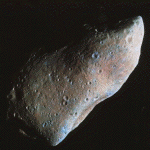More than 160 asteroids have been classified as “potentially hazardous” by the scientists who track them. Some of these, whose orbits come close enough to Earth, could potentially be perturbed in the distant future and sent on a collision course with our planet.

Scientists point out that if an asteroid is found to be on a collision course with Earth 30 or 40 years down the road, there is time to react. Though the technology would have to be developed, possibilities include exploding the object or diverting it.
For every known asteroid, however, there are many that have not been spotted, and shorter reaction times could prove more threatening. NASA puts the odds at 1 in 10,000 of discovering an asteroid that is within 10 years of impact.
Two programs have been set up to actively search for Near-Earth Objects (NEO’s): NASA’s Near Earth Asteroid Tracking (NEAT) program, and Spacewatch at the University of Arizona.
Also, the Spaceguard Foundation was established in 1996 in Rome. The international organization’s goal is to protect Earth from the impacts by promoting and coordinating discovery programs and studies of NEOs. A January report shows that NEOs 1 kilometer or larger are being discovered at the rate of about five a month. The combined goal of these agencies is to find 90 percent of all NEOs 1 kilometer or larger within the next decade.